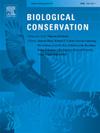从遭遇到死亡:在牲畜掠夺研究中考虑了哪些捕食阶段?
IF 4.4
1区 环境科学与生态学
Q1 BIODIVERSITY CONSERVATION
引用次数: 0
摘要
食肉动物对牲畜的捕食,被称为牲畜掠夺,对牲畜所有者和捕食者的保护产生了负面影响。尽管在全球范围内实施了各种管理干预措施,但对捕食者行为和捕食者-猎物生态的考虑通常并未处于这一发展的前沿。然而,预测不同的捕食者物种和牲畜在掠夺事件中的行为的能力可能会导致更多基于证据和量身定制的干预措施,从而提高长期有效性。根据Lima和Dill(1990)提出的形成性捕食者-猎物理论,我们将捕食过程划分为几个连续的阶段,在这些阶段中发生关键的捕食决策。这些阶段包括遭遇、互动、攻击、捕获和死亡。然后,我们系统地回顾了掠夺文献,量化了每个阶段的研究成果。我们发现,到目前为止,死亡阶段是最常被评估的阶段(96%的回顾性研究,548项研究中n = 522项),其他阶段被评估的频率要低4到30倍。在被回顾的研究中,只有1.5%(548项中有8项)对这些阶段进行了实时的视觉观察或记录。我们描述了在每个阶段考虑掠夺性过程的重要性,并讨论了当前对牲畜死亡后临时数据或代理数据的收集和分析的关注如何限制干预的有效性。我们为各个阶段的研究提供实用的建议,强调相关的方法和未来研究的新途径。将生态学和行为学原理纳入掠夺研究应能更好地理解捕食者-牲畜的动态,并能更有效地进行干预。本文章由计算机程序翻译,如有差异,请以英文原文为准。

From encounter to death: Which stages of predation are considered within livestock depredation research?
The predation of livestock by carnivores, known as livestock depredation, negatively impacts livestock owners and predator conservation. Although various management interventions have been implemented globally, considerations of predator behaviour and predator-prey ecology have not generally been at the forefront of this development. Yet, an ability to predict how different predator species and livestock behave during a depredation event may lead to more evidence-based and tailored interventions with increased long-term effectiveness. We divided the depredation process into successive stages during which key predatory decision-making takes place, informed by the formative predator-prey theory developed by Lima and Dill (1990). These stages include encounter, interaction, attack, capture, and death. We then systematically reviewed the depredation literature to quantify research effort alignment with each stage. We found that the death stage was by far the most commonly assessed (96 % of reviewed studies, n = 522 of 548), with other stages considered four to 30 times less frequently. Only 1.5 % of reviewed studies (n = 8 of 548) made real-time visual observations or recordings of any of these stages. We describe the importance of considering the predatory process across each of these stages and discuss how current focus on the collection and analysis of post-hoc data following livestock death or proxy data may limit intervention effectiveness. We provide practical advice for the study of all stages, highlighting relevant methodologies and novel avenues of future research. Integrating ecological and behavioural principles into depredation research should lead to a better understanding of predator-livestock dynamics, and more effective interventions.
求助全文
通过发布文献求助,成功后即可免费获取论文全文。
去求助
来源期刊

Biological Conservation
环境科学-环境科学
CiteScore
10.20
自引率
3.40%
发文量
295
审稿时长
61 days
期刊介绍:
Biological Conservation is an international leading journal in the discipline of conservation biology. The journal publishes articles spanning a diverse range of fields that contribute to the biological, sociological, and economic dimensions of conservation and natural resource management. The primary aim of Biological Conservation is the publication of high-quality papers that advance the science and practice of conservation, or which demonstrate the application of conservation principles for natural resource management and policy. Therefore it will be of interest to a broad international readership.
 求助内容:
求助内容: 应助结果提醒方式:
应助结果提醒方式:


